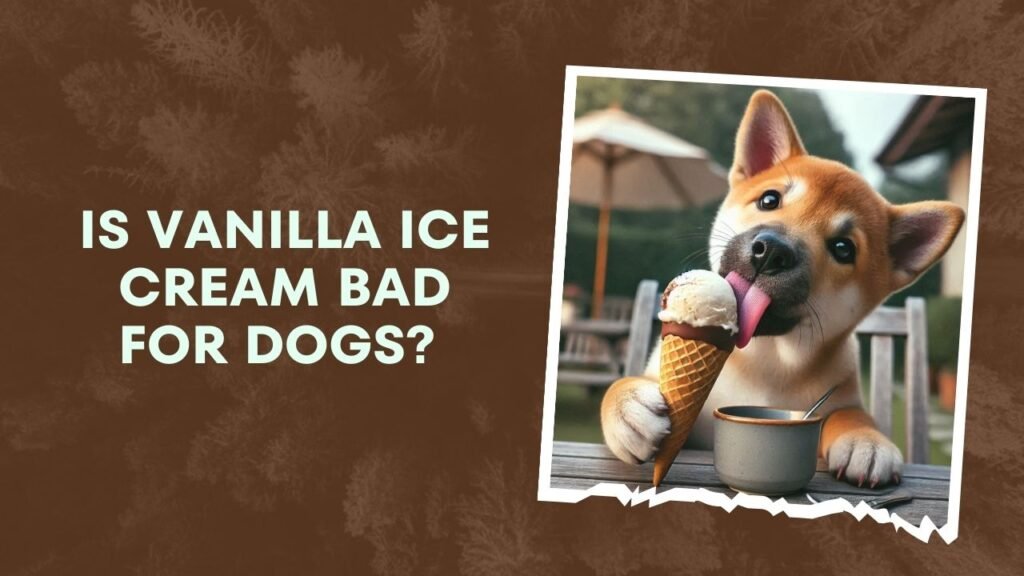Is Vanilla Ice Cream Bad For Dogs? Vanilla ice cream can cause digestive issues for dogs due to its lactose content, especially for those that are lactose intolerant.
As a dog owner, you might find yourself tempted to share your favorite treat with your furry friend.
Vanilla ice cream, with its creamy texture and sweet taste, is a popular treat for many humans, so it’s only natural to wonder: can dogs have vanilla ice cream?
While it might seem like a harmless indulgence, there are several factors to consider before offering this frozen dessert to your dog.
In this post, we’ll explore the potential risks of giving vanilla ice cream to your dog and suggest safer alternatives.
Contents
What Is Vanilla Ice Cream?
Before we dive into whether it’s safe for dogs, let’s first take a closer look at what vanilla ice cream is made of.
Ingredients in Vanilla Ice Cream
Vanilla ice cream typically contains three main ingredients: dairy, sugar, and vanilla flavoring. [Is Vanilla Ice Cream Bad For Dogs?]
The creamy base comes from milk and cream, while sugar adds sweetness, and vanilla provides its signature flavor.
Some brands may include additional ingredients, such as stabilizers and emulsifiers, to enhance texture and shelf life.
Types of Vanilla Ice Cream
You’ll find several types of vanilla ice cream, such as regular, low-fat, and dairy-free versions. [Is Vanilla Ice Cream Bad For Dogs?]
While these may seem like safer alternatives, it’s important to remember that not all of them are ideal for dogs, even if they are lactose-free or have reduced fat content.
Can Dogs Eat Vanilla Ice Cream?
You may have heard that it’s okay to treat your dog with a little ice cream from time to time. However, feeding dogs human food, including vanilla ice cream, should always be done with caution.
Overview of Feeding Dogs Human Food
Dogs have different nutritional needs compared to humans, and many foods we consume can be harmful to them. [Is Vanilla Ice Cream Bad For Dogs?]
Although a small quantity of vanilla ice cream isn’t likely to be harmful to healthy dogs, restraint is crucial.
Regularly giving your dog human food like ice cream can lead to various health issues, such as obesity and digestive discomfort.
Potential Risks of Vanilla Ice Cream
Even though vanilla ice cream might seem like a harmless treat, it’s important to know the risks involved.
In addition to the common ingredients, ice cream can also contain additives, such as artificial sweeteners, that can be toxic to dogs.
Most notably, xylitol, a sugar substitute found in some ice cream brands, is highly toxic to dogs and should be avoided at all costs.
Lactose and Dogs
One of the main concerns when it comes to giving dogs ice cream is lactose. Lactose is the natural sugar found in milk, and dogs can have difficulty digesting it.
Lactose Intolerance in Dogs
Just like many humans, most dogs are lactose intolerant, meaning they lack the necessary enzyme (lactase) to break down lactose in their digestive system.
When lactose-intolerant dogs consume dairy products, they may experience gastrointestinal distress. [Is Vanilla Ice Cream Bad For Dogs?]
How Lactose Affects Dogs
Lactose can lead to upset stomachs, gas, bloating, and diarrhea in dogs. In some cases, more severe symptoms, such as vomiting or dehydration, can occur.
If your dog has never had ice cream before, it’s important to monitor them closely for any signs of discomfort after consumption.
Signs of Lactose Intolerance
If your dog shows signs of discomfort, such as a bloated stomach, excessive gas, or loose stools, it’s a clear indication that they have consumed too much lactose.
If symptoms persist, contact your veterinarian for further advice. [Is Vanilla Ice Cream Bad For Dogs?]
Potential Health Risks of Vanilla Ice Cream
Aside from lactose intolerance, there are other health risks to consider when giving your dog vanilla ice cream.
Sugar and Artificial Sweeteners
Vanilla ice cream is packed with sugar, and dogs don’t process sugar the same way humans do. Regularly consuming sugary foods can lead to obesity, diabetes, and tooth decay.
In addition, some ice creams contain artificial sweeteners like xylitol, which is extremely dangerous for dogs.
Hypoglycemia (low blood sugar), seizures, liver failure, and in severe cases, death, can all result from even minute doses of xylitol.
Weight Gain and Obesity
Overfeeding your dog high-calorie treats like vanilla ice cream can contribute to weight gain and obesity. [Is Vanilla Ice Cream Bad For Dogs?]
Extra pounds can put unnecessary strain on your dog’s joints and organs, leading to a range of health issues such as heart disease, diabetes, and decreased quality of life.
Digestive Problems
If your dog consumes too much ice cream, the high-fat and sugar content can upset their digestive system.
Symptoms like vomiting, diarrhea, and a general lack of appetite are common when dogs eat foods that are too rich or heavy for their digestive system.
Alternatives to Vanilla Ice Cream for Dogs
So, if vanilla ice cream isn’t the best treat for your dog, what are some safer alternatives? Luckily, there are plenty of dog-friendly frozen treats that you can make at home or buy from pet stores.
Dog-Friendly Frozen Treats
Many pet stores offer frozen treats that are designed specifically for dogs, made with safe ingredients like yogurt, peanut butter, and pureed fruits.
These treats are often lactose-free and much easier on your dog’s stomach. [Is Vanilla Ice Cream Bad For Dogs?]
How to Make Homemade Dog Ice Cream
Making homemade dog ice cream is easy and can be a fun way to treat your dog without the risk of harmful ingredients.
A simple recipe includes blending plain yogurt (lactose-free if necessary), banana, and peanut butter. [Is Vanilla Ice Cream Bad For Dogs?]
Pour the mixture into ice cube trays or silicone molds, freeze, and serve as a cool treat for your dog on a hot day.
When Is It Okay to Give Vanilla Ice Cream to Dogs?
While it’s generally not recommended to give your dog vanilla ice cream, there are certain situations where it may be acceptable in moderation.
Moderation
If you’re planning to give your dog a small amount of vanilla ice cream, make sure it’s only an occasional treat. Don’t make it a regular part of their diet, and always monitor them for any signs of discomfort afterward.
Consider Your Dog’s Tolerance
If your dog is lactose intolerant or has a sensitive stomach, it’s best to skip the ice cream altogether. [Is Vanilla Ice Cream Bad For Dogs?]
However, if your dog can tolerate small amounts of dairy without any issues, a little vanilla ice cream here and there may be okay. Always start with a tiny portion to see how they react.
Special Cases
For dogs that are lactose-intolerant, you can look for lactose-free ice cream or non-dairy frozen treats made from ingredients like coconut milk. These options can provide the cold, creamy treat without the digestive issues.
See Also: Is Chapstick Bad For Dogs? Important Facts
FAQs
Is It Safe to Give My Dog Ice Cream Once in a While?
In small amounts, vanilla ice cream may be safe for some dogs, but it’s important to monitor your dog for any signs of discomfort.
What Happens if My Dog Eats Too Much Vanilla Ice Cream?
Eating too much can lead to digestive issues such as diarrhea, vomiting, or bloating. Over time, it could contribute to obesity.
Are There Ice Cream Brands That Are Safe for Dogs?
Yes, there are dog-friendly ice creams made with safe ingredients like yogurt, peanut butter, and fruit, which are easier on a dog’s digestive system.
Can I Give My Dog Vanilla Ice Cream if It’s Lactose-Free?
Lactose-free ice cream may be a safer option for lactose-intolerant dogs, but it’s still important to be cautious and give only in moderation. [Is Vanilla Ice Cream Bad For Dogs?]
What Should I Do if My Dog Shows Signs of a Reaction?
If your dog experiences symptoms like diarrhea, vomiting, or lethargy after eating vanilla ice cream, stop giving them the treat and consult your vet for advice.
Conclusion: Is Vanilla Ice Cream Bad For Dogs?
While it may be tempting to share your vanilla ice cream with your dog, it’s not the best treat for them due to the risks associated with lactose, sugar, and artificial sweeteners.
Opting for safer, dog-friendly frozen treats or homemade alternatives can ensure your dog gets a refreshing snack without the potential for digestive upset or other health issues.
Always remember to offer treats in moderation and watch for any signs of discomfort, keeping your dog’s health and well-being in mind.
Call to Action
Next time you’re enjoying a scoop of vanilla ice cream, remember to keep it to yourself. Treat your dog with something healthier and specifically designed for them to enjoy a tasty treat without the risks.
If you’ve found this post helpful, share it with fellow dog owners so they can keep their furry friends safe and happy! [Is Vanilla Ice Cream Bad For Dogs?]

Derrick Wilcox is a certified canine behaviorist with over 12 years of experience at Happy Paws Animal Clinic and Pawsitive Training Center, helping pet owners ensure safer, healthier, and happier lives for their dogs.



